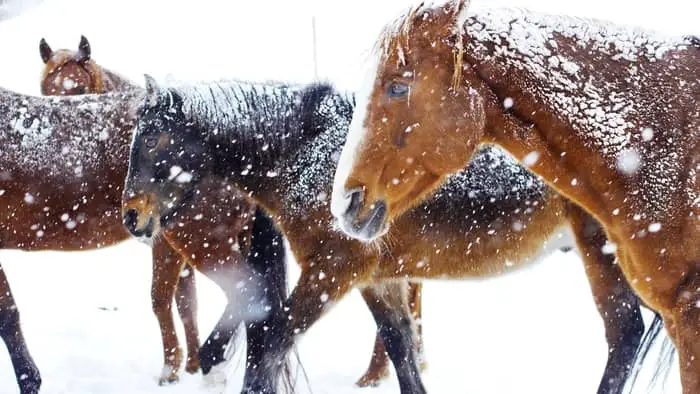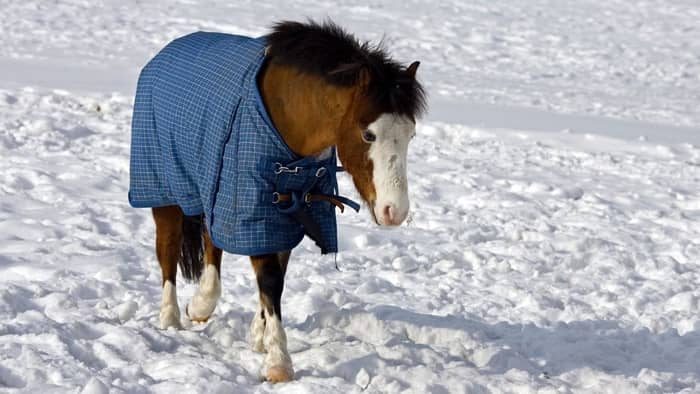Last Updated on February 24, 2023
In the colder months, we all start to worry that our horses might get cold. But what happens when a horse gets too cold?
It is vital that a horse is able to maintain the correct body temperature in order to stay healthy. This means that we need to make sure that they do not get too hot or too cold. Let’s take a look at what happens when a horse gets too cold, and how to help them stay warm.
What Happens When A Horse Gets Too Cold?
Horses are amazingly adaptable, and most horses can cope well with temperatures that are warmer or colder than normal. As the temperature starts to drop, the horse’s body has certain mechanisms that help it to cope with colder weather.
Firstly, during the winter your horse will grow a thick winter coat. This traps a layer of warm air against the skin – as effective at retaining warmth as us as putting on a thick sweater! In the right conditions, a horse can stay comfortable in temperatures as low as minus 40 degrees Fahrenheit.
However, this system does not work if the horse cannot shelter from wind, rain, sleet, and snow. Windswept hair will lose heat quickly, as will wet hair. A horse will get cold much quicker in windy, wet weather than a still, frosty morning.
Horses are also able to generate heat through the digestion of food. This is because horses eat mainly roughage – grass and hay – which is fermented in the large intestine. The fermentation process generates large amounts of heat, creating an impressive central heating system!
When a horse gets cold, it will need to use much more energy to keep warm. In extreme cold, it may start to shiver. It is common for horses to reduce their water intake in colder weather, which can lead to other health problems.
If a horse is allowed to get cold for long periods, or if this occurs frequently, then it will become debilitated and susceptible to disease. This is a particular problem in older or thin horses.

How To Tell When A Horse Is Cold?
In colder weather, it is important to ensure that your horse is warm enough. Firstly, have a look at how he is standing – is he hunched up with his tail tucked in and his back raised? If so, he might be feeling the cold!
If you stand a bit closer, you might be able to see him shivering. The hairs on his body will be stood on end to trap warm air, and his skin will be twitching in an attempt to generate heat.
Next, feel your horse’s body to see if he feels warm. Check behind the ears and under his girth – you should feel some heat here. If not, then your horse is too cold and needs warming up!
You should also check to see if your horse’s coat is wet. A wet horse cannot keep warm, as it can’t trap warm air against the skin. If your horse is wet he needs taking inside to dry off.
Can Horses Get Colds?
Horses are susceptible to many diseases that are similar to the human cold. These are all infectious respiratory disorders and are normally transmitted from horse to horse.
A horse that is run down and debilitated, such as one that is cold, is much more likely to catch a respiratory infection. Horses that are stressed or immunocompromised are also highly susceptible to these disorders.
-
Horse cold symptoms
The different infectious upper respiratory tract disorders of horses all have similar symptoms. You may notice that your horse has a cough, or see discharge from the nostrils. He may appear dull and depressed, with a reduced appetite.
Clinical examination of a horse with an upper respiratory tract infection will normally reveal that they have an elevated temperature. The lymph nodes might be swollen, and the horse may make a noise when breathing. A horse with a cold-like virus will have difficulty exercising and will rest for long periods.
If you suspect that your horse has a respiratory infection, then you should seek veterinary advice as soon as possible. The horse should be kept isolated to reduce the risk of infection to other horses.
Tough 1 600D Waterproof Poly Miniature Turnout Blanket
How To Keep A Horse Warm?
It can be a fine balance trying to keep our horses at just the right temperature! This can be especially difficult if the weather conditions are changeable. Many horse owners will know the pain of putting an extra rug on their horse, only for the sun to suddenly appear!
The most important thing you can do to keep a horse warm is to give them shelter from wind and rain. A horse with a thick winter coat can withstand very cold temperatures as long as he has shelter.
You might think that a rug is needed to keep your horse warm, but this might be counterproductive. This can reduce the ability of the horse’s coat to trap warm air, as the hairs are squashed by the rug. However, if you have very wet weather, a waterproof rug will keep your horse dry.

In colder weather, free access to hay will give your horse the best chance of keeping warm. A steady supply of roughage will give him the calories he needs to maintain his body temperature. However, make sure this is given in a place where he can shelter from extreme weather.
Summary
So, as we have learned, when a horse gets too cold it will start to shiver and will use large amounts of energy to keep warm. If the horse is cold for long periods, it will become debilitated and more susceptible to diseases. It is vital that a horse has shelter from wind and rain to be able to maintain its body temperature in cold weather.
We’d love to hear your thoughts on what happens when a horse gets too cold! Do you have a horse that starts to shiver at the slightest chill? Or perhaps you’ve got a tough pony that likes to live outside in all temperatures? Leave a comment below and we’ll get back to you!

Kate Chalmers is a qualified veterinary nurse who has specialized in horse care for the vast majority of her career. She has been around horses since she was a child, starting out riding ponies and helping out at the local stables before going on to college to study Horse Care & Management. She has backed and trained many horses during her lifetime and competed in various equestrian sports at different levels.
After Kate qualified as a veterinary nurse, she provided nursing care to the patients of a large equine veterinary hospital for many years. She then went on to teach horse care and veterinary nursing at one of the top colleges in the country. This has led to an in-depth knowledge of the care needs of horses and their various medical ailments, as well as a life-long passion for educating horse owners on how to provide the best possible care for their four-legged friends.
Kate Chalmers BSc (Hons) CVN, Dip AVN (Equine) Dip HE CVN EVN VN A1 PGCE

